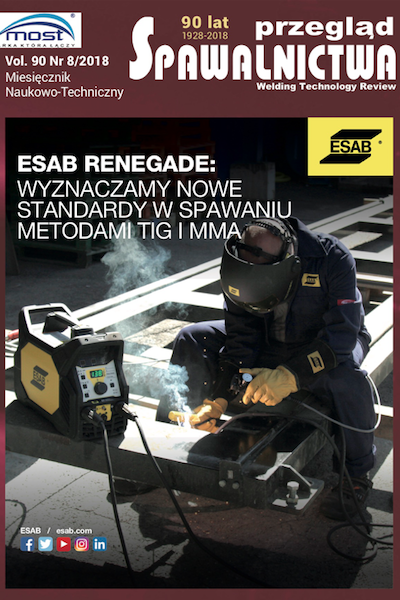Evaluation of the structure and selected properties of aluminum alloy and titanium joints welded with the CMT method
Main Article Content
Abstract
The article presents the problems related to arc welding- brazing hot-melt electrode in the gas shield of 5754 aluminum alloy sheets with titanium Grade 2. The possibilities of making such joints using innovative low-energy welding methods have been indicated. The results of metallographic and mechanical tests (static shear test, microhardness measurements) of weld brazed joints made by the semiautomatic CMT (Cold Metal Transfer) method have been presented.
Downloads
Article Details
Creative Commons CC BY 4.0 https://creativecommons.org/licenses/by/4.0/
Welding Technology Review (WTR) articles are published open access under a CC BY licence (Creative Commons Attribution 4.0 International licence). The CC BY licence is the most open licence available and considered the industry 'gold standard' for open access; it is also preferred by many funders. This licence allows readers to copy and redistribute the material in any medium or format, and to alter, transform, or build upon the material, including for commercial use, providing the original author is credited.
References
Winiowski A., Majewski D.: Brazing of titanium with aluminum alloys, Archives of Metallurgy and Materials, Vol. 62, No. 2, 2013, pp. 763-770.
Li Y.J., Wang J., Liu P.: Weld of dissimilar metals and their applications in industries, Chemical Industry Press, Beijing 2003.
Cao R., Sun J.H., Chen J.H.: Mechanisms of joining aluminum A6061T6 and titanium Ti6Al4V alloys by cold metal transfer technology, Science and Technology of Welding and Joining, Vol. 18, No 5, 2013, pp. 424-433.
Wilden J., Bergman P.: Manufacturing of titanium/aluminum and titanium/steel joints by mean of diffusion welding, Welding and Cutting Vol. 3, 5/2004, pp. 285-290.
Moller F., Grden M., Thomy C., Vollersten F.: Combined laser beam welding and brazing process for aluminum titanium hybrid structures, Physics Procedia 12/2011, pp. 215-253.
Pfeifer T., Stano S.: Nowoczesne metody lutospawania w aspekcie jakości i właściwości połączeń, Przegląd Spawalnictwa, nr 9/2016, s. 95-102.
Wojdat T., Kustroń P., Lange A., Łącka I.: Badanie właściwości złączy lutospawanych aluminium ze stalą wykonanych przy użyciu spoiw na bazie Al i Zn, Przegląd Spawalnictwa, nr 7/2017, s. 22-25.
Gawrysiuk W.: Technologia lutospawania łukowego. Zalecenia technologiczne i przemysłowe przykłady zastosowań, Biuletyn Instytutu Spawalnictwa, vol. 49 (3), 2005, s. 35-40.
Klimpel A., Czupryński A., Górka J.: Lutospawanie metodą GMA cienkich blach ocynkowanych, Przegląd Spawalnictwa, nr 8-9/2004, s.81-85.
Wojdat T., Kustroń P., Skuratowicz F., Michalak P., Piotrowska P.: Zastosowanie niskoenergetycznego procesu CMT do lutospawania złączy miedź-stal kwasoodporna w różnych osłonach gazowych, Przegląd Spawalnictwa, nr 1/2018.
Matusiak J., Czworonóg B.: Niskoenergetyczne procesy spawania łukowego w osłonie gazów do łączenia cienkich blach stalowych, Hutnik Wiadomości Hutnicze, nr 1/2008, s. 10-16.
PN-EN 573-3:2014-02 Aluminium i stopy aluminium Skład chemiczny i rodzaje wyrobów przerobionych plastycznie Część 3: Skład chemiczny i rodzaje wyrobów.
ASTM B265 15 Standard Specification for Titanium and Titanium Alloy Strip, Sheet, and Plate.
PN-EN ISO 18273:2016-02 Materiały dodatkowe do spawania Druty elektrodowe, druty i pręty do spawania aluminium i stopów aluminium Klasyfikacja.
PN-EN ISO 17637:2017-02 Badania nieniszczące złączy spawanych Badania wizualne złączy spawanych.
PN-EN ISO 4136:2013 Badania niszczące złączy spawanych metali Próba rozciągania próbek poprzecznych.
